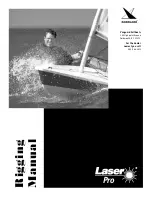
3837 • U3 10/07
3
O
perating
and
M
aneuvering
S
ectiOn
6
If you use a dinghy to reach your yacht, make sure the dinghy line does not
foul the propeller.
After getting onboard, start the engines and send someone forward to
slacken the line. Release the line. In a river with current, the yacht will gain
headway with the current. After you are clear of the buoy, power the yacht
forward. In a calm bay, if there is neither wind nor current, back the yacht
away a few yacht lengths. As you power forward, keep the buoy in sight
and give it ample room until you are clear. Run slowly until you clear the
anchorage to avoid creating a nuisance with your wake.
Picking Up a Mooring
As you return to the anchorage, approach your mooring at slow speed.
Take note of how other yachts are lying at their buoys. They are heading
into the wind or current and your approach course should be roughly
parallel to their heading. Stay clear of other moorings to avoid fouling
them. If you tow your dinghy, station a crew member at the helm to keep
the dinghy line from fouling the propeller.
Shift the engines into neutral when you estimate that the yacht’s forward
momentum will carry you to the buoy. Station someone at the bow with a
yacht hook to pick up the pennant float. If you are about to overshoot your
mark, check headway as the bow comes up to the buoy. If you fall short,
a few turns of the propeller should get you to the buoy. Keep the engine
running until the pennant eye has been secured on the bitt or bow cleat.
If your crewman can not reach the pennant or if you overshoot, get clear
and calmly try again.
Checking headway
Stopping the yacht’s forward motion is referred to as “checking headway.”
You should learn how to confidently stop your yacht within any required
distance. You can check headway by shifting engines to neutral and
coming to a complete stop over a long distance, or by reversing engines
and stopping within a shorter distance.
Towing
Always offer assistance to a vessel in distress. However, towing a
capsized yacht or a yacht with a damaged hull is not recommended. In
these situations, lend aid to the occupants and call the proper authorities.
Remember, you are obligated to lend aid to any person in distress, but not
to the vessel. If you believe your vessel can not tow the vehicle in distress,
do not attempt it. One disabled yacht is better than two.
Anchoring
An anchor’s holding power depends on its weight and the length of the
anchor
line. The most effective length is six to seven times the depth of the
water you intend to anchor in. For example, if the water is 10 feet deep,
you should have 60-70 feet of anchor line.
https://www.boat-manuals.com/
















































